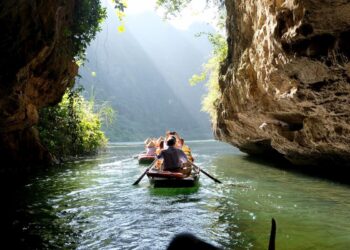As tensions on Europe’s eastern frontier intensify, Finland is adopting an unconventional strategy in its defense posture against Russia-turning to the natural landscape itself. In a move that underscores the country’s unique geographic and strategic position, Finnish authorities are leveraging forests, lakes, and rugged terrain as a new line of defence. This approach not only reflects Finland’s deep connection to its environment but also signals a shift in military thinking amid evolving security challenges in the Arctic region. Our report delves into how nature is becoming a critical asset in Finland’s efforts to safeguard its sovereignty.
Finland Leverages Arctic Landscapes to Strengthen Border Security
In response to increasing geopolitical tensions, Finland has innovatively utilized its Arctic environment to reinforce its northern border. The vast, rugged landscapes offer natural obstacles that are being integrated into a sophisticated surveillance system. By combining traditional border patrols with cutting-edge technologies like drones, thermal cameras, and motion sensors, Finnish authorities are maximizing the difficult terrain to monitor and deter unauthorized crossings effectively. This strategic approach not only minimizes the need for physical barriers but also leverages the extreme climatic conditions to Finland’s advantage.
Key elements of Finland’s Arctic border security strategy include:
- Deployment of autonomous surveillance drones adapted for sub-zero temperatures
- Integration of satellite data with ground sensors for real-time border activity tracking
- Utilization of the region’s deep snow cover and frozen waterways as natural deterrents
- Collaborative exercises involving local defense forces and indigenous communities familiar with the terrain
| Security Component | Function | Benefit |
|---|---|---|
| Arctic Terrain | Natural barrier | Limits movement, slows infiltration |
| Surveillance Drones | 24/7 aerial monitoring | Extends reach over vast areas |
| Thermal Sensors | Detect heat signatures | Tracks individuals day and night |
| Community Collaboration | Local expertise and support | Improves response times |
Harnessing Natural Barriers Enhances Strategic Defense Capabilities
Finland’s strategic defense approach is increasingly leveraging the country’s rich natural topography to create formidable defensive strongholds. Expansive forests, rugged terrain, and frozen waterways are being integrated into military planning to hinder potential advances and provide tactical advantages. These natural barriers not only complicate enemy movement but also offer concealed positions for surveillance and countermeasures, reducing reliance on conventional man-made fortifications. Experts highlight that this symbiosis between nature and defense infrastructure embodies a cost-effective yet resilient approach to national security.
The Finnish defense forces are focusing on key elements that amplify the effectiveness of natural geography, including:
- Dense boreal forests: creating natural camouflages and ambush opportunities
- Frozen lakes and rivers: acting as natural moats in winter months
- Uneven terrain: slowing mechanized units and restricting armored vehicle maneuvers
Below is an illustrative breakdown of how these elements contribute to defensive operations:
| Natural Feature | Strategic Benefit | Operational Impact |
|---|---|---|
| Forests | Concealment & ambush | Limits visibility; favors guerrilla tactics |
| Frozen Waterways | Natural barrier | Restricts heavy vehicles; seasonal defense line |
| Hilly Terrain | Movement obstruction | Slows enemy advance; defines choke points |
Experts Urge Sustainable Preservation of Ecosystems for Long-Term Security Advantages
Amid escalating geopolitical tensions, experts emphasize the critical need to integrate sustainable ecological strategies into national security frameworks. Finland’s innovative defense approach underscores how the preservation of pristine forests, wetlands, and Arctic tundra not only strengthens natural barriers but also enhances resilience against potential adversarial advances. These rich ecosystems serve as vital carbon sinks and climate regulators, creating a multi-dimensional shield that extends beyond traditional military capabilities.
Specialists advocate for policy measures focusing on:
- Maintaining biodiversity to prevent ecosystem collapse and preserve habitat connectivity.
- Restoring degraded landscapes to fortify environmental stability and defense utility.
- Integrating indigenous knowledge to sustainably manage natural resources and safeguard cultural heritage.
| Benefit | Security Impact |
|---|---|
| Carbon sequestration | Climate stabilization reducing conflict triggers |
| Habitat protection | Preservation of natural terrain for strategic advantage |
| Water regulation | Ensures availability for civilian and military needs |
Final Thoughts
As Finland strengthens its defenses amid rising regional tensions, the country’s innovative integration of natural landscapes into military strategy marks a significant shift in Arctic security dynamics. While challenges remain, this approach underscores Finland’s commitment to safeguarding its sovereignty through a blend of traditional defense measures and environmental awareness. Observers will continue to watch closely as nature becomes a critical element in the evolving balance of power in the North.
















